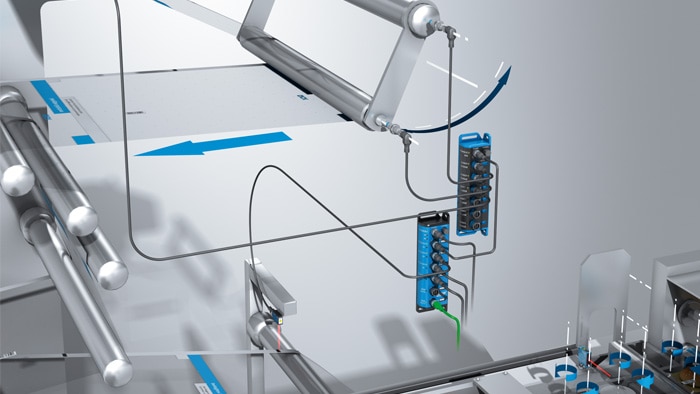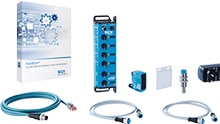To meet market demands and streamline costs, Corex Plastics P/L in Australia has stepped up its game in tightening its back-end systems. John Hughes, automation technician from Corex Plastics, and Amit Shinde, technical sales engineer from SICK, show how the right connectivity guarantees greater efficiency and lower costs.
Superior connectivity for better workflow
Established in 1985, Corex Plastics is an independent private business in Australia that has grown from extruding semi rigid twin wall sheet into a fully integrated polymer product business involving manufacturing, packaging fabrication & recycling products for its broad range of customers. Today, operating 24/7 Corex’s well-known brands include Fluteboard®, Corflute®, Imageboard®, Versamount®, Stericor® to name a few and are used for many applications such as signboards, solar heating panels, automotive tote boxes, fresh produce packaging, bulk packaging, divider boards, vacuum forming, slip sheets, pallets, as well as drum and cable protection products packaging. Supplying to a national customer base, they also export its products worldwide and have won a number of international innovation awards.
John Hughes, automation technician from Corex Plastics explained that its flagship product is Corflute®, a twin wall plastic board used in a broad range of applications as substitute for derivative cardboard products particularly where reuse, a wet environment or durability is required. Additionally, the company manufacturers other extruded sheet products in semi rigid sheet that then fabricated into downstream fabrication processes into a broad range of products across industry.
“We supply sheet product or full turnkey fabricated product directly to end users alike. Utilizing a range of processes, some developed in-house, we can provide tailored products to meet a unique requirement of a customer from conventional plastic boxes for produce, seafood, distribution centers and other demands of modern supply chains. Then at end of useful like we can take the product back for reprocessing and reuse. This is achieved with our recovery process managed by the Corex Recycling division that accepts end of life polymer materials to which we can reprocess back in a useable raw material for use in our sheet extrusion process or on sell back to industry for other applications. In this way we offer the full circle of plastic use and recovery”, Hughes said.
“It’s a growing business and we’ve worked right through COVID – it hasn’t stopped, so it’s been quite a busy time for us because we supply products to the food industry and other essential industries,” he added.
The importance of a sound automated system: error-free, fast, efficient
For a business like Corex that requires a high volume of output for its customers, speed and efficiency are key while keeping bottom line costs down. So, in the production line, having a sound, error-free and practical back-end system to keep the workflow smooth, is important, as Hughes explained further.
“My role here at Corex is that of an automation technician and I do industrial programming. My goal here is to automate the machines around the plant,” said Hughes. “This has been helped greatly by using quite a few SICK sensors and other devices that got the job done.” He mentioned that he consulted with Amit from SICK about his interest in getting into the IO-Link connection to improve the current systems with specific applications. “I’ve used other types of networks, but IO-Link is very functional, very practical,” he said. “Typically, you’d run a sensor all the way back to the main cabinet and there would be a lot of wiring involved – you have to rewire it all the way back. However, IO-Link is a universal protocol across the industry, and I was presented with these modules that have a master and also a slave version.”
Installation made easy with only one network and one power cable
The application of the protocols works out for Corex, as Hughes explained, because instead of running physical cables to each sensor back to the main cabinet, one network (daisy chained) and one power cable can be run from the IO-Link master back to the main cabinet for ease of installation and collection of information needed.
“We monitor our air supply to measure the air supply within the plant, where we can calculate the level and usage of air. Another application we monitor raw materials silos, so we always know the current capacity and usage of the silos at a point of time. This is all through the SIG200 Sensor Integration Gateway via an Ethernet connection back to the PLC or central unit,” Hughes said. “Traditionally, I used other applications and had to go out and spend thousands of dollars for a separate PLC which need to separately program each device to get those signals and send them on, whereas this as an alternative is this case the SICK IO-Link master collects the information from sensors then centralise PLC does all the heavy lifting at a much lower cost, that does essentially the same thing – data communication.”
Real-time data transmission – less costs, more quality of efficiency
One of the new applications at Corex is to setup production line monitoring across the site that can be displayed on a computer, large TV, tablet, or mobile phone, etc. in real time. This information can be the speed of the line, uptime/downtime, how efficiently we produce the finished products and how many rejects there were. All of this information was hardwired back to the centralized PLC with the SIG200 IO-Link master.
“You’re able to get the same or more amount of information at a tenth of the price,” Hughes said. “It’s very cost-effective, when a simple on/off signal can be used to calculate the rejection ratio you don’t need a fancy device – that’s where it gives the saving and functionality.” Hughes said that his team was going through the motion to monitor each of Corex’s sites and was impressed at the cost savings he got with the quality of efficiency he received. “Instead of spending $5,000, we would spend under $1,000 on each line.” he said. “It is low in cost and a very practical device that meet our requirements.”
Simplified industry with SICK IO-Link master and sensors
Hughes said that he had dealt with SICK prior to this inquiry at other manufacturing plants and he feels that SICK would provide very good solutions.
“They’ve got so much of the industrial range covered – like a one-stop shop to get your machine up and running,” Hughes said. “I’ve used them for safety devices and other applications across the plant. It’s not just here, but at other sites as well. Overall, I’ve been very happy with the reliability of the device for the current applications and I think a lot of thoughts has been put into the product development as well.”
He explained that it is not just the IO-Link master that’s got the power in it but also the sensors. “It’s an industry standard now and you can actually see how many times it has been triggered in the past or what temperature it is running at or whether it is dirty or it is not working at optimum performance because it needs cleaning or if the sensor is failing – that sort of information you were never able to get out a of a standard sensor. IO-Link is giving me so much more data at the sensor level, let alone at the production level and the Master can pull it out and share it upstream to other devices – it’s just simplified industry as a whole basically,” he said.
Intuitive software and great service support
Amit Shinde, technical sales engineer from SICK who was in touch with Hughes through the implementation said that when it comes to after support, Hughes was provided application videos, as well as Shinde’s personal technical expertise to support the implementation and installation. “Apart from this, we also have a technical department to help John in simplifying the understanding of our new products,” Shinde said. “As a team from SICK, we supported John so he can upgrade IO-Link connectivity in his factory.”
“They’ve been very supportive, and their software is fairly intuitive, and I believe that I’ve picked it up fairly quickly,” Hughes said. “It is not over complicated to understand, really, because once your device is connected to a network, you can connect via a web browser. “Any questions I have, if I think whether I should be doing it this way or that way, I’ll get on the phone and I can get the answers pretty quickly, so I’d say on the whole, it’s very simple. There’s a couple of different modes you can use, so anybody who has a technical background won’t have a problem with using the module itself – I wasn’t waiting weeks and months for an answer,” Hughes said.
“That’s one of the things about SICK. It is a good product and a good company and they stand by that product.”
Read more
IO-Link: Industry 4.0 for everyone
Function Block Factory: The open universal solution for the creation of IO-Link function blocks
FieldEcho® – IO-Link taken a step farther
Digital world of sensors: "We make valuable information accessible."
I want to stay up to date and regularly be informed about new articles!











